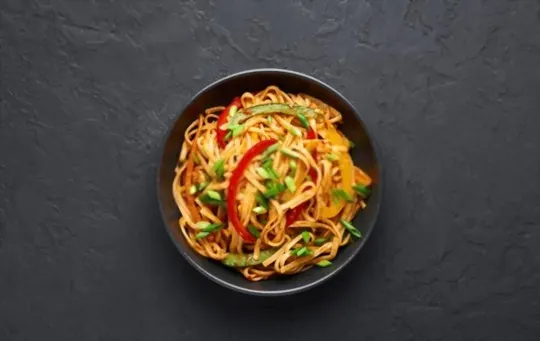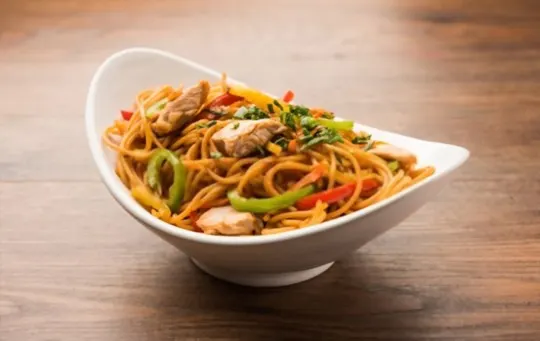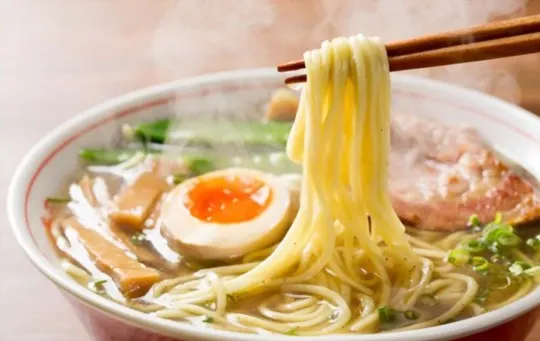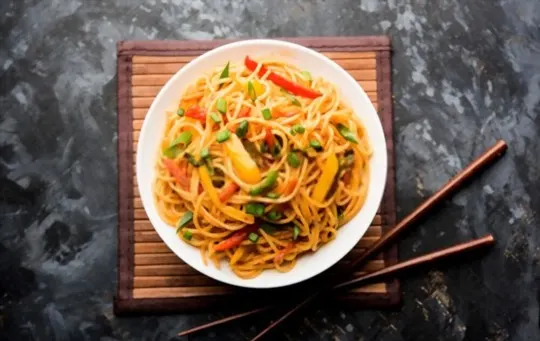Okay, folks, we’re here to slice through the confusion like a hot knife through butter. Ramen and Noodles. Yes, we’ve all been there, standing in the grocery aisle, scratching our heads.
Ramen? Noodles? Aren’t they just the same thing with different names?
Pull up a chair. We had this debate last Thursday night. Almost ruined our dinner plans.
Ramen is not just a quick meal for college students. It’s an art form in Japan.
Noodles? They’re the globetrotters of the food world. From Italy to China, they’ve got a passport filled with stamps.
We’ll admit it. We thought spaghetti in ramen was a genius hack. Spoiler: it’s not.
Ready to get the lowdown on this culinary mix-up?
What is Ramen?

Ramen, a popular Japanese noodle dish, is made from wheat-based noodles served in a savory broth.
The noodles are typically thin and springy with a chewy texture and are often served with toppings such as sliced pork, boiled egg, and green onions.
Ramen varies in flavor depending on the region it originated from in Japan, but it usually consists of soy sauce, miso, or pork bone broth.
Its popularity has spread worldwide due to its unique taste and versatility in preparation.
What are Noodles?

Noodles are wheat or rice-based ingredients that are cooked into various shapes and sizes, typically long and thin.
They form an integral part of cuisine across cultures, with some variations in preparation methods.
They can be eaten fresh or dried, boiled or fried, paired with soups or sauces.
As a popular ingredient worldwide, noodles have been modified according to local tastes to accommodate dietary restrictions like veganism and gluten-free diets.
In Southeast Asia, for instance, they serve dishes such as Pad Thai or Laksa using rice noodles made from ground rice flour, water, and salt.
In China, they prepare dishes like chow mein and lo mein using wheat flour noodles that are longer and thicker than those found elsewhere.
Japanese cuisine features udon and soba noodles made from buckwheat flour.
Noodles have been a staple food for over 4,000 years globally – with mentions dating back to Chinese records in 2-3 BCE.
Despite variations in how they’re prepared across cultures – the basic concept of noodle-making remains similar – which is very little more than just combining ground grain (rice/wheat/other) mixed with water until it becomes dough-like consistency before cutting them up into various shapes/sizes depending on your desire.
Differences Between Ramen and Noodles

Ramen and noodles are often used interchangeably, but they are actually two different types of dishes.
While both contain wheat flour, water, and salt, the key differences lie in their preparation and ingredients.
Origin and Cultural Significance
Japanese Noodles have a rich history and are an essential part of Japanese cuisine.
These noodles also have cultural significance in Japan.
The tradition originated during the Edo period, where the Japanese primarily consumed wheat-based noodles.
Later in 1859, Chojiro Hattori created Ramen, which quickly became widespread throughout Japan and obtained pop-culture status.
Ramen is different from ordinary noodles as it is made with wheat flour and enriched with alkaline water.
In contrast, regular noodles can be made out of a variety of flours like rice, wheat, potato or cornstarch.
Additionally, Ramen has an extended shelf life compared to traditional noodles as it can sit on shelves for months.
While both Ramen and noodle dishes share similarities like ingredients and contrasting textures — the main differences lie in the thickness and whether or not they’ve been boiled.
Generally speaking, noodle dishes tend to be thinner than ramen with smooth texture while ramen tends to be cut into thick strips or waves giving it a distinctive texture.
Knowing the culturally significant history behind these two beloved dishes helps one appreciate them even more.
Ingredients and Preparation Methods
The components and cooking techniques of Ramen and Noodles are distinct.
To start, the ingredients utilized in preparing each dish determine their diversity.
In general, ramen consists of wheat noodles alongside a meat or soy-based broth and toppings such as egg, pork, seaweed and scallions.
Meanwhile, noodles encompass a broad range of dishes such as chow mein or stir-fry where a variety of sauces are used with the favored type of noodle.
The preparation techniques used to make these dishes come in different forms too.
Using an alkaline substance such as water and soda ash to regulate the pH levels of the noodle batter often results in firmer and denser ramen noodles than regular wheat flour noodles which makes them perfect for soups that require cooking at high heat for longer periods.
In contrast, standard noodles can be ready in minutes with little boiling after being boiled or soaked in hot water.
Furthermore, apart from the distinction in ingredients and preparation methods between ramen and noodles, they boast unique flavors that cater to distinct palettes.
Ultimately choosing one over the other arises down to individual preference and dietary requirements.
Broth and Seasonings
The savory broth and unique seasonings are essential components of both ramen and noodles.
The broth in ramen is typically made from pork bones, chicken bones or vegetables, while noodles can be paired with a variety of broths or sauces.
Aromatic herbs and spices like ginger, garlic, miso paste, and soy sauce are commonly used to flavor both ramen and noodles.
When it comes to seasonings, ramen has a more diverse range than traditional noodles.
It often incorporates chili oil, sesame seeds, pickled bamboo shoots, nori seaweed and many other flavorful additions.
Noodles mostly rely on basic seasoning such as salt or sugar alone.
However, variations also add subtle flavors such as vinegar to the mix.
Moreover, customization is easier with ramen when it comes to broth and seasoning selection compared to traditional noodle dishes which are more limited in these aspects.
In summary, the richness and diversity of the broth and seasoning profile is what sets ramen apart from plain noodle dishes.
Texture and Thickness
The characteristics of Ramen and Noodles, especially pertaining to texture and thickness, can be quite distinct.
While Ramen is known for having a chewy and springy texture with a medium thickness, Noodles come in various forms and textures.
However, most traditional noodles are known for being thinner than Ramen and having a smoother texture.
This difference in texture can alter the overall taste of the dish and provide a unique experience to those consuming it.
Another variation that sets the two apart is the method through which they are prepared.
Typically, Ramen is made with alkaline water that helps maintain the desired texture while boiling, whereas noodles use regular water or ingredients like eggs to achieve their ideal consistency.
Additionally, some noodle variants can also be fried or stir-fried in preparation.
When it comes to cooking time, Ramen usually takes less time to prepare as compared to noodles that may require more time.
The cooking method also plays a significant role in determining the overall texture of both dishes.
Similarities Between Ramen and Noodles

Ramen and noodles share some similarities that may not be obvious at first glance.
They both have Japanese origins and are made of wheat flour, water, and salt.
Additionally, they can be served hot or cold and topped with sauces, meats, and vegetables to create diverse flavors.
However, the key differences lie in their preparation method and texture.
Ramen is boiled before it is served, while noodles can be prepared in various ways such as stir-frying or deep-frying.
Moreover, ramen has a distinctive chewy texture due to the use of kansui water during the dough-making process.
Regional Variations of Ramen and Noodles
Ramen and noodles may seem similar, but they have distinct regional variations.
Different cultures have their unique way of preparing and serving these dishes.
The differences in variations range from texture, ingredients, broth, toppings, sauce and the overall presentation.
For instance, Ramen has its origins in Japan and is classified based on the regions it comes from.
It also has several kinds of broths like pork bone broth, soy sauce broth or miso broth.
In contrast, noodles come from various Asian countries like China, Korea and Vietnam and can be either dry or wet.
In Chinese cuisine, noodles are served with stir-fried vegetables and meat at home or boiled as a separate dish in restaurants.
Vietnamese noodle soup includes a beef broth base with rice noodles and a variety of meats while Korean cold noodle dishes have an icy chill to beat the summer heat.
Popular Ramen and Noodle Dishes
Popular dishes made with noodles and ramen are distinct in their preparations and origins.
Noodles have been around for thousands of years and come in various textures and shapes, while Ramen is a type of Japanese noodle soup that has become popular worldwide.
Here are some must-try dishes:
- Pho.
- Pad Thai.
- Ramen.
- Laksa.
- Soba Noodles.
Each dish has different ingredients, spices, broths, and cooking methods that create unique flavors and textures.
While both noodles and Ramen are widely enjoyed globally, they have several distinguishing features.
Ramen is prepared with wheat flour, salt, water, and kansui; noodle dishes can be made from rice flour or wheat.
In contrast to plain noodles, ramen broth is strongly flavored with meat or fish stock seasoned with soy sauce.
Conclusion
As we conclude this analysis, it’s clear that while all ramen is noodles, not all noodles can be called ramen.
The differences between these two lie in the ingredients and preparation techniques, which are unique to each type.
Ramen boasts a chewy texture due to the addition of kansui, while other types of noodles like udon and soba rely on wheat flour alone.
Additionally, ramen has its own distinct broth made from meat or fish stock, soy or miso sauce which makes it different from other types of noodle dishes.
Lastly, the toppings of ramen vary greatly and some even include egg, pork belly slices, and seaweed.

Ramen vs Noodles: What’s the Difference?
Ingredients
- Ramen
- Noodles
Instructions
- Choose between ramen and noodles based on your preference and the dish you want to prepare.
- Follow the cooking instructions provided for your chosen option, ensuring proper boiling or soaking times.
- Cook the ramen or noodles according to the recommended method until they reach the desired tenderness.
- Drain the cooked ramen or noodles and rinse them with cold water to prevent sticking (if required).
- Incorporate the cooked ramen or noodles into your dish of choice, whether it’s a soup, stir-fry, or salad.
- Adjust the seasoning and add any desired toppings or ingredients to enhance the flavor and texture.
- Mix or combine the ramen or noodles with the other components of your dish, ensuring even distribution.
- Serve and enjoy the delightful taste and texture of the ramen or noodles in your culinary creation.
- Experiment with different recipes and variations to explore the versatility and diverse possibilities of using ramen or noodles in your meals.

Andrew Gray is a seasoned food writer and blogger with a wealth of experience in the restaurant and catering industries. With a passion for all things delicious, Andrew has honed his culinary expertise through his work as a personal chef and caterer.
His love for food led him to venture into food writing, where he has contributed to various online publications, sharing his knowledge and insights on the culinary world. As the proud owner of AmericasRestaurant.com, Andrew covers a wide range of topics, including recipes, restaurant reviews, product recommendations, and culinary tips.
Through his website, he aims to inspire and educate fellow food enthusiasts, offering a comprehensive resource for all things food-related.

Leave a comment